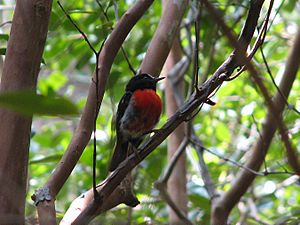Norfolk robin facts for kids
Quick facts for kids Norfolk robin |
|
|---|---|
 |
|
| On Norfolk Island, Australia | |
| Conservation status | |
| Scientific classification | |
| Genus: |
Petroica
|
| Species: |
multicolor
|
| Synonyms | |
|
|
The Norfolk robin (Petroica multicolor) is a small, pretty bird. It's also known as the Norfolk Island scarlet robin or Norfolk Island robin. This bird belongs to the Australasian robin family, called Petroicidae. It lives only on Norfolk Island, which is an Australian territory. Norfolk Island is located in the Tasman Sea, between Australia and New Zealand.
Contents
About the Norfolk Robin
For a while, people thought the Norfolk robin was the same as the scarlet robin found in Australia. But in 1999, scientists decided it was different. Then, in 2015, it was officially named its own unique species.
What Does the Norfolk Robin Look Like?
The Norfolk robin looks a lot like the Pacific robin and the scarlet robin. The adult male bird is very easy to spot. Its top feathers are mostly black. It has a big white spot on its forehead and white stripes on its wings. Its tail also has tiny white tips. The male's chest and upper belly are bright red, while its lower belly is white.
The female Norfolk robin is not as colorful as the male. She is mostly brown with a pinkish chest. Young birds look similar to the females. The Norfolk robin is the biggest bird in the Pacific robin group. However, it is a little smaller than the scarlet robin.
Where the Norfolk Robin Lives
The Norfolk robin only lives on Norfolk Island. You can mostly find it in the Mt Pitt section of the Norfolk Island National Park. It also lives in some other forest areas nearby. This bird prefers to live in native subtropical rainforests. You might also see it in other wooded places, but not as often.
It likes areas with lots of thick bushes and an open ground. It looks for places with deep, moist leaves and dirt. This is where it finds its food.
What the Norfolk Robin Eats
The Norfolk robin eats many different kinds of small creatures without backbones. These are called invertebrates.
Protecting the Norfolk Robin
In the 1980s, the number of Norfolk robins went down a lot. They even disappeared from some parts of the island. But after that, their numbers seemed to stay steady. In 1988, there were about 400 to 500 pairs of these birds. This number didn't change much by 1997.
However, the Norfolk robin still faces dangers. Its home is getting damaged, and it is hunted by black rats and feral cats. Because there are not many of these birds and they live in a small area, the IUCN Red List considers them an Endangered species.
To help protect them, people are working to control rats and wild cats. This helps stop the birds from being hunted. They are also removing invasive weeds that can harm the bird's home. There are plans to move some Norfolk robins to nearby Phillip Island. This will happen when the forest there grows back enough to be a good home for them.
See also
 In Spanish: Petroica de la Norfolk para niños
In Spanish: Petroica de la Norfolk para niños


